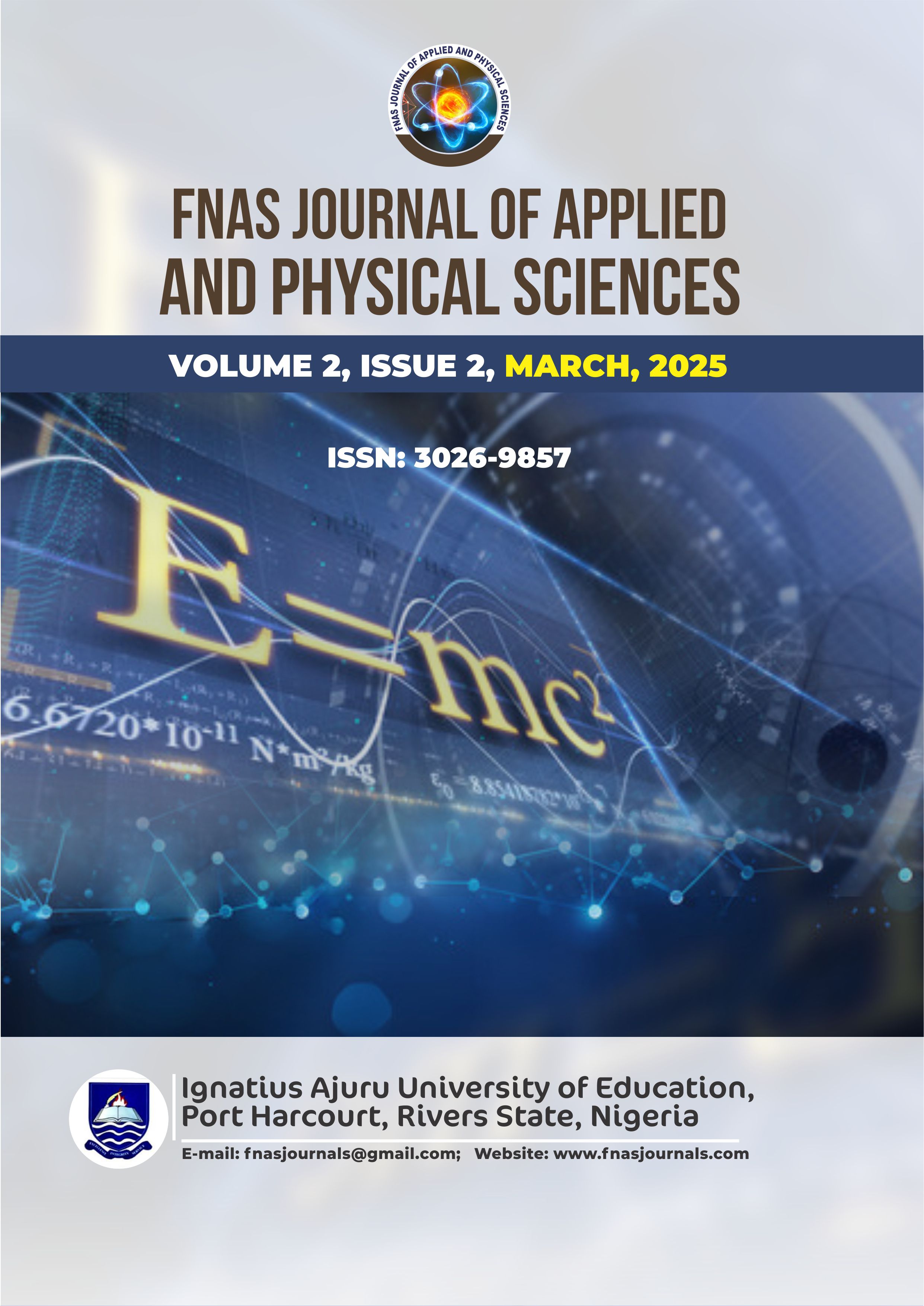Assessment of Ingested Radionuclide Dose from Groundwater Sources in Rumuekpe, Rivers State, Nigeria
Keywords:
Consumption, Recommended, Inhabitants, Homogeneity, ConcentrationAbstract
A study to evaluate the annual effective dose (AED) of radionuclides due to consumption of well water samples from some randomly selected communities in Rumuekpe, Emohua Local Government Area, Rivers State, Niger Delta, Nigeria, was carried out. The aim of the study is to determine the annual effective dose in infants, children and adult population of the study area who consume the well water. Twenty-eight well water samples were collected and acidified to allow for homogeneity as well as to minimize the effect of microbial/bacterial activities. Activity concentration (AC) of radionuclides was determined with the aid of NaI gamma-ray spectrometer. Mean AC of 40K, 232Th and 238U are 79.51, 2.73 and 9.67 Bql-1 respectively. Mean TAED of all radionuclides in infants (0-1 and 1-2)yr, children (2-7 and 7-12)yr and adults (12-17 and ˃17)yr are (3.703 and 1.085), (1.169 and 0.861), and (1.368 and 1.093) mSvy-1 respectively. Mean activity concentration of 40K and 232Th are above recommended safe limit of 10.0 and 0.10 Bql-1 respectively while that of 238U was lower than the 10.0 Bql-1 recommended safe limit. Mean TAED in infants, children and adults are higher than the recommended safe limit of 0.26, 0.20 and 0.10 mSvy-1 respectively. This indicates that the well water supplies are harmful for human consumption. Proper water treatment or provision of good water supplies is highly recommended for the inhabitants of the study area.
References
Akinloye, M. K. (2008). Radioactivity in LAUTECH Water Supplies, Nigeria. Nigerian Journal of Physics, 20(1), 29-37.
Aliyu, A. S., Ibrahim, U., Akpa, C. T., Garba, N. N., & Ramli, A. T. (2015). Health and Ecological Hazards Due to Natural Radioactivity in Soil from Mining Area of Nasarawa State. Isotopes in Environmental and Health Studies, 51(3), 448-468.
Anekwe, U. L., Uzoekwe, S. A., & Ibe, S. O. (2023). Estimation of Health Risks in Borehole Water Supply, Case Study in Ogbia, Nigeria. Open Scientific Publishers Journal of Health Care and Medicine, 4(1), 1-8.
Ajayi, I. R. (2008). Background radioactivity in the Sediments of Some Rivers and Streams in Akoko, Southwestern Nigeria and their Radiological effects. Research Journal of Applied Sciences, 3(3), 183-188.
Avwiri, G. O., Tchokossa, P., & Mokobia, C. E. (2007). Natural Radionuclides in Borehole Water in Port Harcourt, Rivers State, Nigeria. Radiation Protection Dosimetry, 123(4), 509-514.
Chigbo, M. (2011). How Shell promoted criminal gangs in Niger Delta. Newswatch Magazine.
www.newswatchngr.com/index.ph
Dankawu, U. M., Shuaibu, H. Y., Maharaz, M. N., Zangina, T., Lariski, F. M., Ahmadu, M. Zarma, S. S., Benedict, J. N., Uzair, M., Adamu, G. D., & Yakubu, A. (2021). Estimation of Excess Life Cancer Risk and Annual Effective Dose for Boreholes and Well Water in Dutse, Jigawa State Nigeria. Dutse Journal of Pure and Applied Sciences (DUJOPAS), 7(4), 209-218.
International Commission of Radiological Protection, ICRP (2012). Compendium of Dose Coefficients based on ICPR Publications 60. Annals of the ICRP 41 (suppl) 42(4), 1-130.
Igbudu, O., & Briggs-Kamara, M. A. (2023). Determination of Effective Dose of Radionuclides in Water Samples on Infants from Communities Along the Banks of New Calabar River, Rivers State, Nigeria. International Journal of Microbiology and Applied Science, 1(1), 85-93.
Igbudu, O., Briggs-Kamara, M. A., & Amakiri, A. R. C. (2023). Assessment of Annual Effective Dose in Children Due to Intake of Water Samples from New Calabar River, Rivers State, Nigeria. International Journal of Scientific Development and Research (IJSDR), 8(10), 849-860
Ononugbo, C. P., & Anyalebechi, C. D. (2017). Natural Radioactivity Level and Radiological Risk Assessment of Surface Water from Coastal Communities of Ndokwa East, Delta State, Nigeria. Physical Science International Journal, 14(1), 1-14.
Jegede, O., Kasali, S. O., & Matthew, K. T. (2017). Evaluation of Natural Radioactivity and Radiological Health Implication of Oniru Beach, Lagos, South-Western, Nigeria. Journal of Environmental Science, Toxicology and Food Technology (IOSR-JESTFT), 11(10), 65-74.
Ononugbo, C. P., Avwiri, G. O., & Egieya, J. M. (2013). Evaluation of Natural Radionuclides Content in Surface and Ground Water and Excess Lifetime Cancer Risk Due to Gamma Radioactivity. Academic Research International, 4(6), 636-647.
Ononugbo, C. P., & Ndodo, N. N. (2019). Annual Effective Dose and Lifetime Cancer Risks Due to Natural Radioactivity in Hand-Dug Well Water of Tai Rivers State, Nigeria. Journal of Scientific Research and Reports 24(5), 1-10.
Ononugbo, C. P., & Tutumeni, G. (2016). Natural Radioactivity and Radiation Dose Estimation in Various Water Samples in Abua/Adua Area, Rivers State, Nigeria. Physical Science International Journal (PSIJ), 11(4), 1-12
Smith, D. (2011). Shell Accused of Fueling Violence in Nigeria by Paying Rival Militants Gangs. A Publication of World News. www.m.guardian.co/world/2011/oct/03
STUK (Radiation and Nuclear Safety Authority, Finland), (2014). Calculation of the Dose Caused by Internal Radiation: Guide ST 7.3. ISSN 1456-8160, ISBN 978-952-309-187-0 (PDF); ISBN 978-952-309-188-7 (html): 8, 20-21.
Tchokossa, P., Olomo, J. B., Fatai, I., & Balogun, A. (2011). Assessment of Radionuclide Concentrations and Absorbed Dose from Consumption of Community Water Supplies in Oil and Gas Producing Areas in Delta State, Nigeria. World Journal of Nuclear Science and Technology, 1, 77-86.
UNSCEAR (2010). United Nations Scientific Committee on Effects of Atomic Radiation. Report to the General Assembly Annex B: Exposure from Natural Radiation Source.United States Environmental Protection Agency (US, EPA 2000). Office of Water Setting Standards for Safe Drinking Water, Revised June 9 (US-EPA, Washington
WHO (2011). (World Health Organization) Guidelines for Drinking Water-Quality, First Edition. WHO Geneva, 460-465.
WHO (2017). (World Health Organization) Guidelines for Drinking-Water Quality. Fourth Edition Incorporating the First Addendum. WHO Geneva, 1-137.





